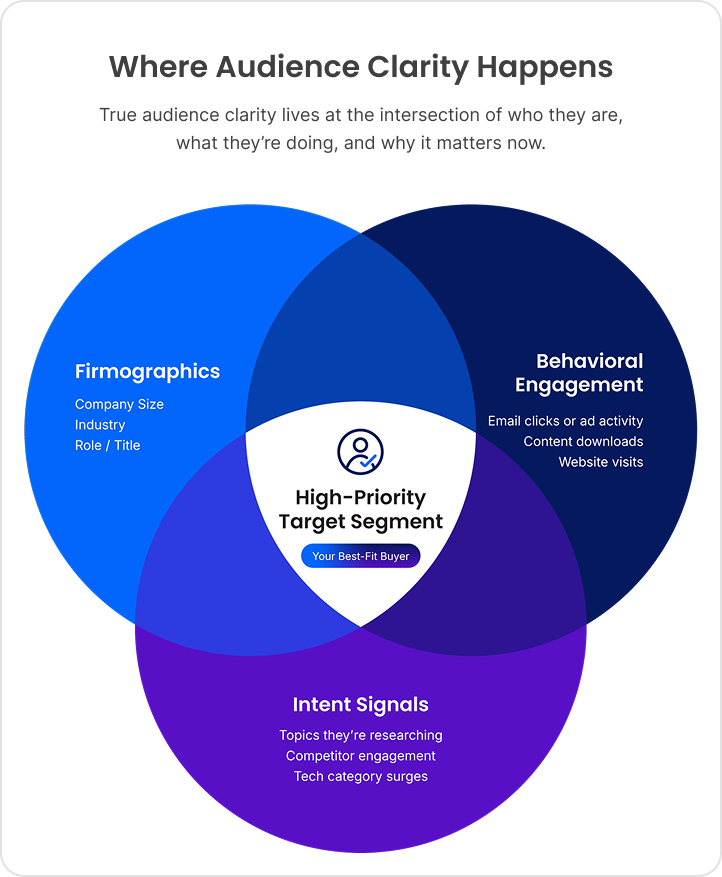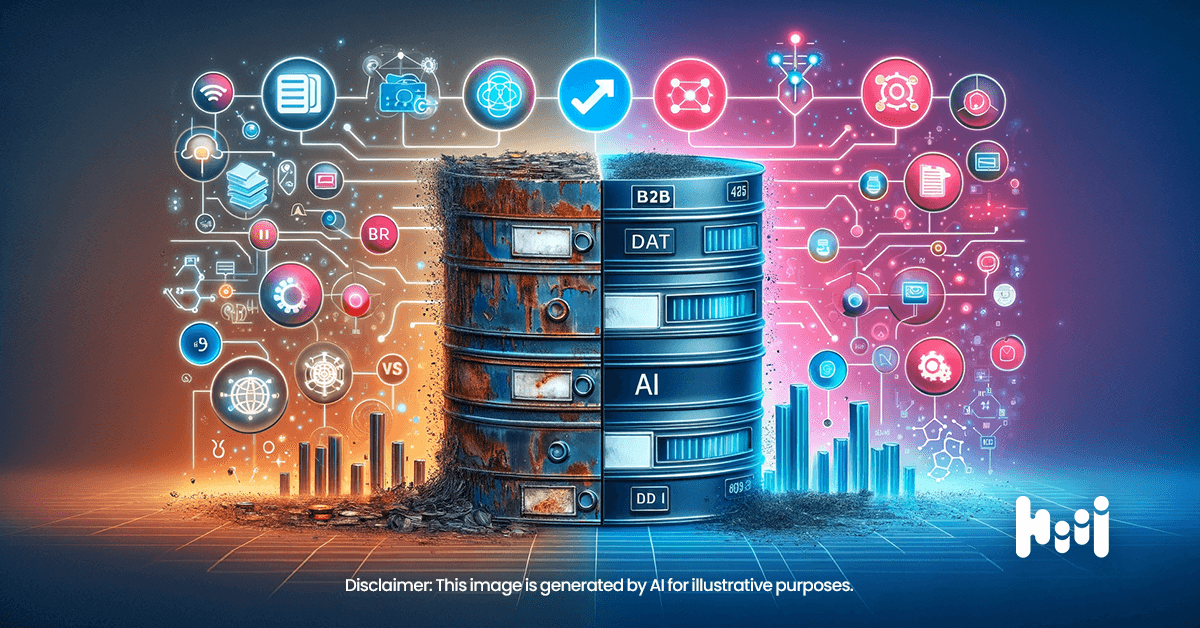Audience First: The Real Starting Point for a Cohesive Digital Experience
July 7, 2025

In the world of B2B marketing, cohesion isn’t just a buzzword. It’s the glue that holds your entire digital strategy together. But here’s the truth: most marketers are starting in the wrong place. They kick off campaigns with creative brainstorming sessions, build channel plans, and launch splashy assets, all before getting crystal clear on who they’re actually trying to reach.
That approach leads to exactly what we’re all trying to avoid: disconnected experiences, misaligned messaging, and campaigns that fall flat before they deliver results.
If you want to build a cohesive digital experience—one that actually earns buyer attention and builds momentum—you have to start with your audience. Not just a surface-level persona or job title. We’re talking about a full spectrum understanding of who your buyers are, how they behave, and what matters to them at the moment.
That’s the foundation. Everything else gets built on top.
Why Audience Clarity Is Non-Negotiable for Cohesion
Today’s B2B buyers don’t operate in silos. They’re part of evolving buying groups that include multiple stakeholders—an average of 11, according to Gartner. These groups are fluid, have shifting priorities based on internal changes, market dynamics, and timing.
You’re not engaging a job title. You’re navigating group dynamics. That means cohesion can’t just be about matching visuals across platforms. It has to be about relevance. Relevance at the group level, relevance at the individual level, and relevance at the moment of interaction.
Audience-first thinking ensures your message resonates at every touchpoint. It transforms disconnected messaging into a conversation that moves buyers forward.
First: Build a Smarter ICP
Start by defining your ICP: What types of companies are the best fit for your solution? Go beyond firmographics like industry or company size—include strategic factors like business goals, growth signals, and tech stack maturity and complexity.
Once you’ve identified the right accounts, then zoom in on the personas that matter. Who’s involved in the buying process? Who controls budget, and who might block progress? It’s the foundation for building more relevant, role-aware engagement throughout the journey.
Here’s how to level up your ICP:
- Surface intent triggers. What signals suggest a company is actively exploring solutions like yours?
- Assess organizational complexity. Is buying centralized or distributed across regions or departments?
- Capture role-specific motivations. What does success look like for a Demand Gen Manager vs. a CMO?
Let’s say you’re targeting mid-market SaaS companies scaling their demand generation efforts. Your ICP might focus on roles like Marketing Directors or Heads of Demand Gen at companies with 100-500 employees, a recent funding round, and a growing tech stack.
That’s sharper than just “B2B tech companies.” And that clarity helps you craft messages that cut through the noise.

Next: Layer in Intent, Behavior, and Timing
Firmographics define your market. Intent and behavior show you where the real opportunity is—right now.
To build a truly cohesive digital experience, you need a dynamic view of your audience. That means combining:
- Intent data: Are they researching specific solutions, pain points, or competitors?
- Behavioral engagement: Have they downloaded content, visited pricing pages, or clicked through multiple ads?
- Recency and frequency: Is their interest growing, cooling off, or surging right now?
When you overlay this data with your ICP, you can segment your audience not just by who they are, but by how ready they are to engage.

Then: From Data to Actionable Segments
Smart segmentation is where insights become action. Break down your audience into meaningful groups based on:
- Funnel stage: Are they just becoming aware or already considering vendors? Understanding where they are in their journey helps you tailor your message to match their mindset.
- Topic interest: Are they engaging with content around ABM, lead scoring, or martech stacks? The topics they care about now give you a window into their current challenges—and a chance to position your solution as the answer.
- Role and function: Decision-maker vs. influencer vs. researcher. Each role interacts with content differently, so aligning your approach to their influence level ensures your message actually resonates.
Example: A Demand Gen Manager who’s downloaded two eBooks on lead scoring but hasn’t visited your site yet? That’s an early-stage signal. Serve them educational content, not a demo request.
Contrast that with a Marketing Director who’s visited your pricing page twice in one week after clicking an intent-driven email. Time to deliver product-centric content and a personalized CTA.
You’re not just segmenting—you’re steering the journey.
Finally: Why It All Matters for Cohesion
Without this kind of audience insight, your campaigns become chaotic. Your ads say one thing, your emails say another, and your landing pages don’t match either. That’s how trust erodes. That’s how engagement stalls.
But when you build from the audience up, everything aligns:
- Your message is tailored and timely.
- Your channels are where your buyers actually are.
- Your journey flows naturally from one step to the next.
It doesn’t feel like a campaign. It feels like relevance. That’s what builds momentum. That’s what drives conversions.
Leading with Audience First
Every successful digital experience starts with clarity. That means having the tools and insight to:
- Define smarter ICPs using enriched data and dynamic segmentation.
- Uncover real-time intent signals that reveal true buyer behavior.
- Activate insights across email, ads, and content syndication—without guesswork.
- Orchestrate cohesive journeys that match where buyers are in the funnel.
DemandScience makes this possible by combining data, technology, and expertise, helping marketers stop operating on assumptions and start building experiences that actually move the needle.
Putting It All Together
A cohesive digital experience starts with data-driven audience insight. When your message reflects real behavior and role-based needs, every touchpoint adds value—and momentum.
That’s how you create experiences that feel personal. That’s how you stand out in a crowded space.
And that’s how you win.
Turn Disconnected Campaigns Into Strategic Journeys










